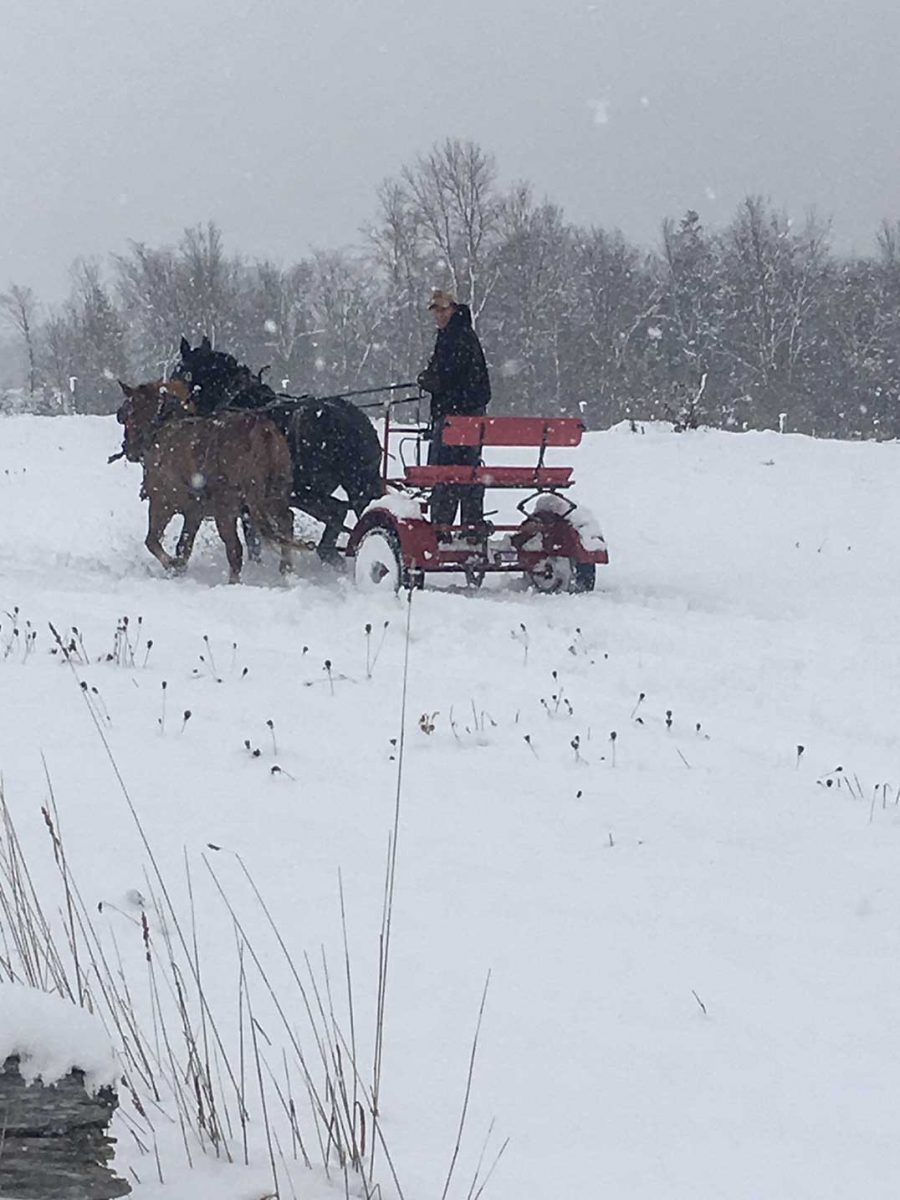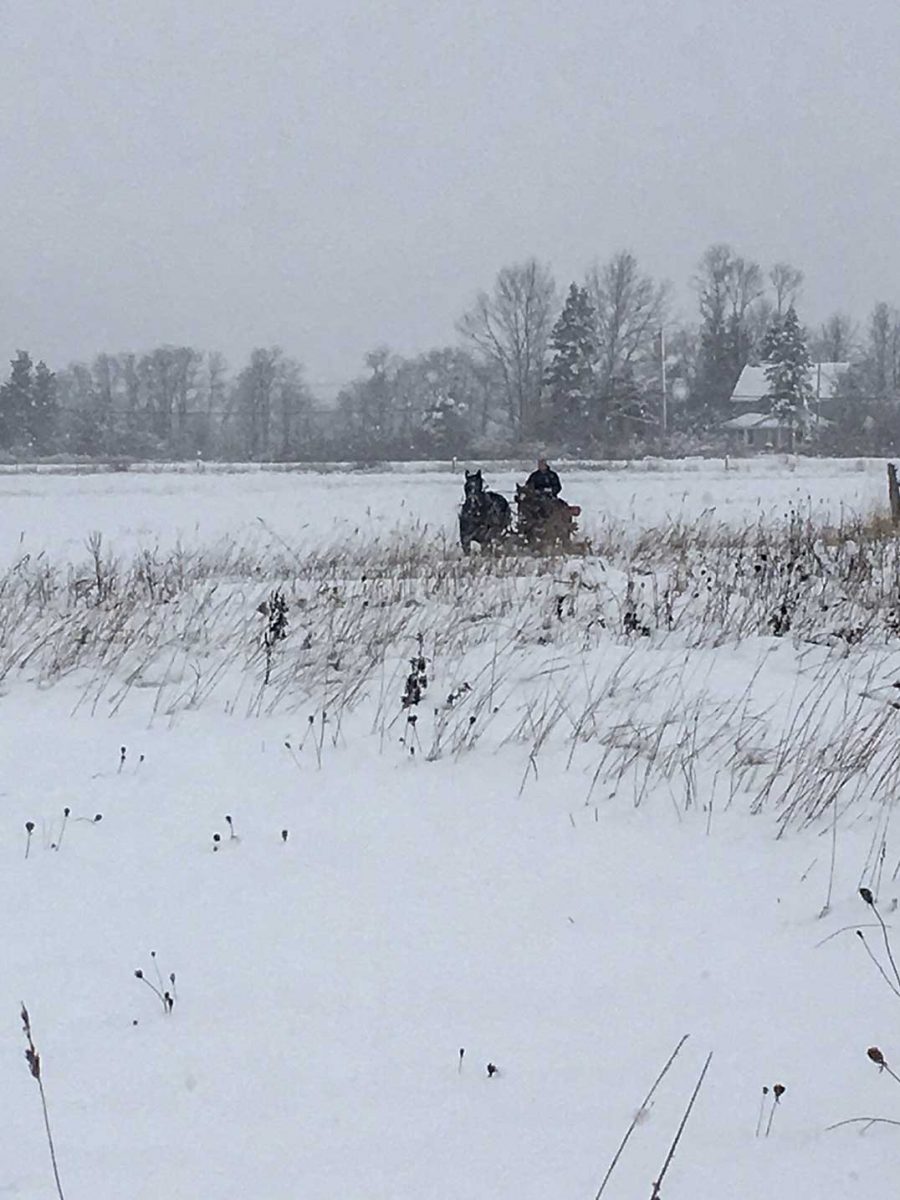Spring Bay man’s services in high demand
SPRING BAY—Emmanuel Kuepfer has been training driving horses all his life and the Spring Bay farmer is finding his services in high demand as the number of horse-drawn vehicles on Manitoulin has been increasing recently.
“My parents are Amish,” explained Mr. Kuepfer. “We have always trained horses.”
The trainer explains that horses should be trained fairly early on, although there are some who feel they should be older than that. “It’s good to start them around two years old with a light drive,” he said. “Kids start learning things much sooner than that if you stop and think about it. You wouldn’t wait until a child was a young adult before you started to show them how to do things, would you?” Just like people, he explains, the longer you wait to show them the right way to do things the more bad habits they will pick up and it is harder to change established habits than to teach someone how to do things the right way, right away.
Mr. Kuepfer can accommodate quite a few horses on his Spring Bay ranch, and he buys and sells horses on a regular basis as well. “I have bought and sold horses for 20 years,” he explained. He estimates he has transferred about 500 horses over the past two decades.
Currently, he can handle about 40 horses at a time. “You don’t work every horse every day,” he explains. “You really couldn’t.”
The horse industry underwent a few difficult years when the province changed the slot machine agreements with race track owners and the provincial subsidies for the racing industry, but things have improved markedly in recent years. “Horse racing is way back up,” he said, and prices have risen quite a bit. “A horse can be worth a good bit of money, if you get a good one,” he said.

Long a familiar sight on southwestern and eastern Ontario roads, horse drawn carriages used to be ubiquitous on Island roads as well, but the dominance of automobiles made them increasingly rare on Manitoulin (although many in living memory recall the days when they were still in quite common use as transport in Island communities). But, with the increase of the number of Amish and Mennonite families choosing to settle on Manitoulin Island in recent years, they are becoming a much more common.
Horse-drawn vehicles are one of the slowest moving of all road users, notes the Ministry of Transportation Ontario (MTO) website. They range from two-person carts to open or closed buggies carrying up to eight people, along with large, wide farm wagons carrying crops, equipment and other goods. “These vehicles will travel primarily on the shoulder of roadways, but may straddle or enter the paved lane where shoulders are narrow or no shoulder exists—such as bridge crossings,” notes the MTO, but cautions, “Remember that it is common to see horse-drawn vehicles throughout southwestern Ontario and increasingly in eastern and Northern Ontario.”
Horse-drawn vehicles on the road must display an orange and red slow-moving sign on the rear of the buggy, but many drivers chose to have reflective tape affixed to the side and rear of the vehicle. This sign warns other drivers that this vehicle is travelling at 40km/h or less and the reflective tape illuminates as headlights hit the buggy.
“If you see a horse-drawn vehicle, slow down and be very cautious,” cautions the MTO. “Maintain a safe following distance and only pass when it is safe to do so. When approaching a horse-drawn vehicle travelling in the opposite direction, move to the far right of your lane. When passing, give as much distance between you and them as possible. Passing too closely could scare or startle the horse, causing it to change direction suddenly on the roadway.”
“A horse is not a car,” said Mr. Kuepfer. “If you pass too close you could startle it and a horse can jump sideways two feet. Even a well-trained horse could jump into trouble. Besides, it is just simple respect.”
Although Island drivers tend to be very accommodating with horse drawn vehicles, generally giving them a wide berth, Mr. Kuepfer said he fears that might because of the novelty. “Down south they are a lot more common and drivers don’t give them the space they should. They just fly by.”

That novelty has also brought with it some challenges when it comes to the general public and driving horses parked on the street. The lack of hitching posts isn’t so much a problem for a well-trained team, but when people come up to horses waiting outside of a store and start petting the animals or clucking they can accidently indicate to the horse that it is time to get going, or startle them. When it comes to children, it is too easy for the horse to accidently step on them or kick if they stand in the wrong place.
A lot of children on Manitoulin do have some farm experience, but an increasing number of younger people have little experience with large animals. The safest course of action is to get your child to understand that they need to stay well clear of the horses.
When it comes to training new driving horses, Mr. Kuepfer said he usually pairs a younger horse with an older and more experienced partner. “They pick up what to do from the older horse, when to go, when to stop.”
When it comes to what local governments can do to make their communities more horse-friendly, Mr. Kuepfer has a few suggestions. “More signs,” he said, “especially where there are places like just as you are coming into Mindemoya, where my parents live. There is a straight stretch with a steep hill, it is hard to make a turn into their driveway from the highway, especially if you have a trailer, even with my truck. Someone coming over the hill can’t really see you in time if they aren’t warned to slow down. That’s a place where there should be a sign.”
In addition to his driving horse training and trading, Mr. Kuepfer will be offering horse drawn buggy/sleigh rides to the general public.
“I have no problem if someone wants to go for a ride sometime,” he said. “Just give me a call and we can arrange something.”
Mr. Kuepfer can be reached at 519-477-6935.



